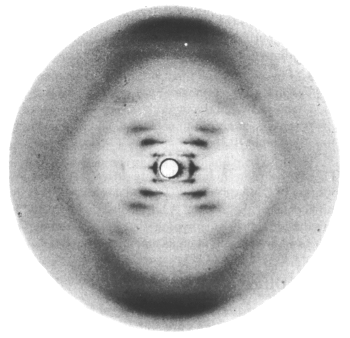

Franklin's X-Ray Crystallography
Experiments:
Refractions & Reflections on the Nature of Science


Franklin's X-Ray Crystallography
Experiments:
Refractions & Reflections on the Nature of Science
Regular substances like crystals diffract X-rays in characteristic patterns according to their physical structure. The X-ray crystallograph at right ("Photo 51") shows an exceptionally clear diffraction pattern of a crystallized DNA molecule. The X-pattern in the middle is characteristic of a helical molecule with regular repeats; the broad bands at top and bottom indicate the periodicity of the repeats. The photograph is of the highly hydrated B form of DNA, rather than the drier A form, which does not show a distinct helical structure. The photo does not, without mathematical analysis, indicate whether there are 2, 3, or 4 helices, which requires measurement of the intervals between elements of the X-pattern.
Under the
supervision Rosalind Franklin
(1920 - 1958), grad student Raymond Gosling (1926 -
2015), made Photo 51 in May 1952. Maurice Wilkins (1916 -
2004), working in the same lab group, with Gosling's assistance
had previously made photos of the B form as early as
1951. Wilkins and Franklin had a severe personality crash, in
part on their mutual misunderstanding that "the DNA problem"
had been assigned to each of them, exclusively. Wilkins
approached DNA as a biological problem, whereas
Franklin approached DNA as a physical problem in
crystalline structure of the A form.
Latter-day
revisionism (e.g., BBC's TV documentary "The Secret of Photo
51") has suggested that Wilkins and (or) Watson gained
improper access to Photo 51, without her
knowledge or permission, such that she was cheated out of proper
recognition. Opinion and evidence vary as to how and
when Franklin interpreted her evidence as bearing on the form
of the DNA molecule. When she decided to leave Kings
College, Franklin delivered her notebooks (including Photo
51) to Wilkins, with instructions to use them as he
wished. Wilkins showed Photo 51 to Watson, who
immediately realized that the X-structure implied two
strands. In combination with his work on model building, the
familiar "Double Helix" with paired
bases on the inside quickly emerged. The DNA model
and crystallographic evidence were published as twin papers in
Nature.
Watson,
Crick, & Wilkins subsequently received the Nobel
Prize in 1962 for solving the structure of DNA.
Wilkins had by then amassed a great deal of additional
crystallographic evidence for the double-helical structure. Franklin had
moved on to other crystallographic studies, notably the
structure of Tobacco Mosaic and Polio viruses. In 1958, she
died of cancer, possibly from exposure to X-rays. The
Nobel is not awarded posthumously, nor to more than three
persons. Watson's POV account of the discovery of "The Double Helix"
(1968) paints an unflattering personal portrait of Franklin, and
has been widely criticized as inaccurate and sexist. Watson,
Crick, and Wilkins repeatedly acknowledged that they could not
have solved the structure without the crystallographic evidence.
HOMEWORK: Priority of discovery, acknowledgement of ideas, and ownership of data continue to be controversial topics in science. The story of the discovery of DNA structure is an exceptionally well-documented one. From the evidence and statements of participants, evaluate and comment on the following statements:
1) Watson and
(or) Wilkins ripped off Franklin, who was badly treated because
she was a woman.
2) If Gosling made Photo 51 while
working for Franklin, who "owned it", and who was
entitled to see it?
3) "Grad students in those days were
treated like serfs."
4) "She was definitely anti-helical."
5) "I showed them the base
pairing, I wasn't properly acknowledged."